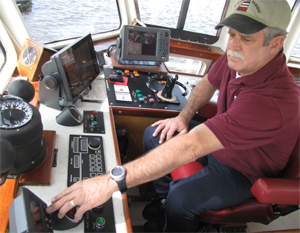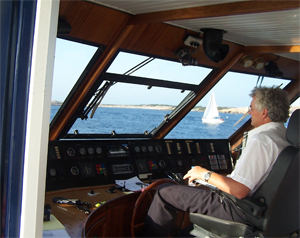Beeps, buzzes and flashing lights are an increasingly common soundtrack for life on the bridge of any modern vessel. Although intended to make operations safer and provide a backup to human judgment, bridge navigational watch alarm systems (BNWAS) have added to concerns about alert overload and response fatigue among mariners.
Initially for larger vessels in global service, International Maritime Organization (IMO) requirements for BNWAS went into effect under the Safety of Life at Sea (SOLAS) convention in 2011. More recently, U.S. Coast Guard Subchapter M rules added similar requirements for operators of vessels with overnight accommodations and alternating watches when pulling, pushing or hauling, known as pilothouse alerter systems.
But all that technology is making some wonder if it is a case of the law of diminishing returns. At the very least, there seem to be doubts about how mariners are reacting.
“Regarding bridge navigational watch alarm systems, it is unlikely that the towing industry has much data regarding their usage at this point in time,” Brian Bailey, director of safety and environmental stewardship for the American Waterways Operators (AWO), told Professional Mariner in November. That’s mostly because under Subchapter M, existing towing vessels more than 65 feet in length are not required to have pilothouse alerter equipment until at least five years after the issuance of the vessel’s first certificate of inspection (COI).
However, Bailey said the frequent sounding of BNWAS alarms — designed to signal attention lapses in the wheelhouse — contribute to alarm fatigue among mariners keeping watch, especially when the notifications are misleading or false.
“A modern wheelhouse is already a highly technical location on board the vessel, with many sounds, all with the potential to distract the pilot from his main task at hand,” he said. “So many alarms, denoting differing risks, problems or conditions, can be confusing and not easily decipherable.”
As a result, Bailey said the AWO plans to monitor this issue as more data becomes available from its member companies.
“Alarm fatigue is a serious concern for watch-standing mariners,” said Capt. Tamara Burback, assistant professor in the Marine Transportation Department at California Maritime Academy. “Coupled with the normal fatigue of daily operations and feeling disconnected from loved ones, alarm fatigue presents a risk that the entire industry should take seriously.”
Unfortunately, with so many electronic systems on the bridge, there is often at least one piece of equipment that is emitting a persistent alarm, Burback said. Usually the most that a vessel operator can do is put in a service request for the next port of call, and in the meantime either learn to live with the alarm or continue to silence it. However, if the alarm does not reflect a major equipment malfunction, it may not be prioritized as highly as other vessel repairs, which means the problem tends to persist, she said.
Nor is there any particular culprit. According to Burback, there is no single piece of bridge equipment that emits more false or non-emergency alarms than other equipment, though attention has often focused on the GMDSS console and more recently ECDIS, water ingress systems, depth sounder, speed log and BNWAS.
“If false alarms are not addressed in a timely manner or are deemed necessary even though they are frequent and unactionable, mariners may be tempted to minimize the volume of the alarm or even shut the equipment off,” Burback said.
The Shipowners’ Club, a London-based protection and indemnity (P&I) insurer, recently teamed up with the Department of Psychology at Royal Holloway, University of London, to conduct a survey on the ways in which alarms affect mariners and ship operations. Almost half of the respondents were masters, followed in frequency by second officers and chief officers. They hailed from vessels ranging from dredgers to pleasure craft, but the top three categories were LPG/LNG transporters, passenger vessels and general cargo vessels.
 |
|
Capt. Larry Sullivan makes an adjustment to the Furuno BNWAS unit on the tugboat Emily Anne McAllister in 2013. Although not required for towing vessels at the time, BNWAS had been added to the wheelhouse during the boat’s five-year overhaul. |
|
Dom Yanchunas photo |
As to whether false alarms represented a problem, nearly 90 percent said yes. A majority also indicated that they found it difficult to determine when alarms were false and when they were not. Respondents also said it was difficult to distinguish between different types of alarms.
Professor Polly Dalton at Royal Holloway said research has identified a phenomenon known as the “cry wolf effect,” which suggests that as the rate of false alarms increases, the less likely a person is to respond. “The general advice is to reduce false alarms as far as possible, but this must be balanced against the risk of the system failing to generate an alert when one is necessary, so these are complex issues,” she said.
Burback said fatigue is dangerous in all forms because “it mutes our sensitivity to what may potentially be the only early warning signs of an impending danger or catastrophe.” Thus, when mariners are told to “just ignore that one,” or that a specific piece of bridge equipment “has always alarmed,” they will likely continue to pass along that information and little will be done to solve the problem. Once alarms become something to be continually ignored, it makes sense that the risk of ignoring serious alarms increases, she said.
According to Bill Haynes, deep-sea product manager at Furuno USA, alarm fatigue should be examined as two separate topics: BNWAS, and then bridge alarms and nuisance alarms. “Both make noise and could cause distractions, but they are different as far as what they are designed to accomplish,” he said.
Before BNWAS, an operator alone on the bridge could fall asleep or become incapacitated due to a health issue and nobody aboard the vessel would know or be alerted until it was too late. Haynes said a quick Internet search reveals dozens of incidents involving operators who fell asleep, or incidents that occurred while BNWAS was shut off.
“There is really no disputing that BNWAS has saved lives and property worldwide,” he said. “Crew fatigue or health-related incapacitation is a reality of life at sea. BNWAS helps prevent disasters from occurring as a result.”
Haynes said there are many ways to make sure that BNWAS does not become a nuisance, adding that many vessel managers have found functionally appropriate ways of ensuring that their BNWAS correctly monitors operator activity. For example, infrared motion sensors can monitor the bridge and reset the timer whenever movement is detected. Radars, ECDIS and operator-initiated steering systems also can send reset signals to BNWAS when operated to further decrease false alarms and bridge distractions.
“If none of these operator-initiated actions are detected, then — and only then — the BNWAS first sounds an alert on the bridge,” he said. “If it is not reset within a reasonable amount of time, alarms are sounded in crew quarters and spaces.”
Haynes said nuisance alarms occur when the source of the alarm is either not understood or when something like a sensor is broken. One good example of a misunderstood alarm is the ECDIS safety contour alarm, which is an alarm required by recently adopted performance standards (IEC 61174-4). If a vessel using ECDIS with an electronic navigation chart (ENC) happens to be in waters with a depth shallower than the value set in the safety contour box, then an alarm will sound. Haynes said in many instances that has created a huge distraction for bridge teams, as they didn’t know where to go to correct the issue — though it is described in operator guides and manuals.
The solution often can be very simple: refreshed training and familiarization. Eventually, with support and education, operators began understanding the purpose of these alarms, and ECDIS became a more useful tool instead of a nuisance and distraction, Haynes said.
“It remains our strong recommendation to any shipping company that fits a new system like a radar, ECDIS or other mandatory bridge equipment to demand and schedule appropriate operator familiarization training so that the bridge team understands operation, including alarms, before the vessel gets underway,” he said.

